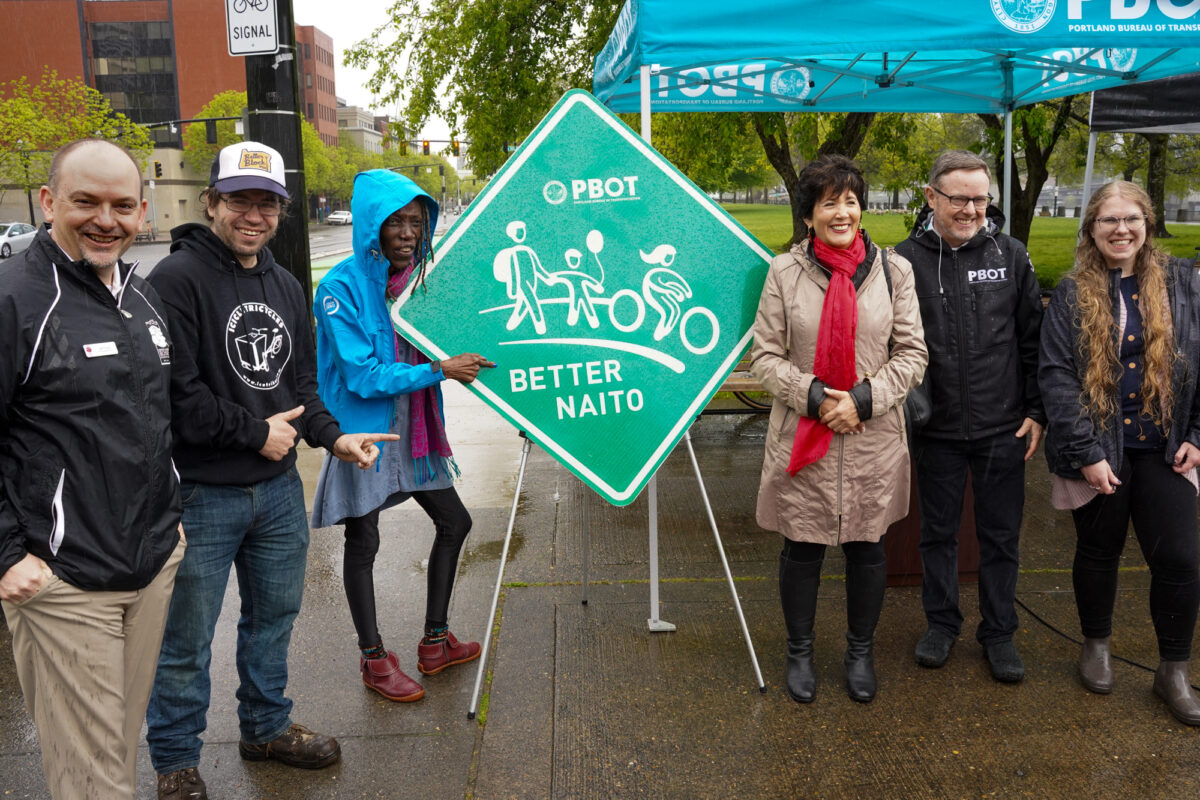
(Photos: Jonathan Maus/BikePortland)
A linchpin in Portland’s efforts to decarbonize its transportation system officially opened today as city leaders cut the ribbon on Better Naito.
Before we get into the recap of the event… Let’s go back a bit in history and recall how a pie-in-the-sky idea floated by former Mayor Charlie Hales in 2011 to create a bike path along the river from Portland to Astoria, manifested itself as a 1.2 mile addition to our active transportation network.
That seed of an idea from Hales bounced around the head of a young tactical urbanism fan named Timur Ender who became a volunteer with Better Block PDX, a nonprofit that creates temporary demonstration projects to show cities what’s possible on their streets. Ender went on to become a policy advisor for former Portland Bureau of Transportation commissioner Steve Novick. The idea gained more steam when elected officials and agency staffers from around the region did a bike ride on the old, narrow lanes as part of the annual Policymakers Ride in 2014. A few months after that ride Ender was relaxing on a hay bale with other Better Block volunteers in the middle of a temporary plaza they helped build on SW 3rd and Ankeny.
“That’s where the idea of Better Naito first came up,” Better Block leader Ryan Hashagen said during a speech at the celebration this morning where he credited Ender for connecting activists to City Hall and setting the gears in motion.
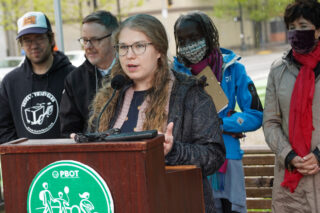
One of those gears was Portland State University’s urban planning school where students had a partnership with Better Block. Former PSU student Gwen Shaw, now a traffic engineer at a local firm, made Better Naito her capstone project. Shaw was there from the beginning. She and her team teamed up with Better Block and PBOT to devise the traffic control plan for the very first iteration of Better Naito that opened on May 22, 2015.
Shaw beamed throughout this morning’s event, hardly able to contain her excitement. “The design is absolutely stunning. It addresses all the things that we never could have done in a temporary fashion.”
Advertisement

PBOT Director Chris Warner also emphasized how the unorthodox origin of this major capital project not only made it possible, it made it better. “One of the great things about Better Naito was the evolution of how we were able to learn things over the years and receive feedback from the community,” Warner said. “I think it’s made it a much better facility than it might have been if we just would have put it in.” Warner said reducing the space for driving on Naito Parkway and improving access for bikers and walkers adjacent to Waterfront Park, is imperative to meeting their goals and to preparing downtown for the return of office workers.
Asked how he responds to people concerned that there’s less room for the increasing number of car drivers in the region, Warner said, “There might be more cars, but more than ever there’s a need to create a multimodal system that works for everyone. And we just have to keep pushing along and making the case and if the facilities aren’t safe, people aren’t going to ride. The safer the facilities are, the more ability we’ll have to really change the culture.”
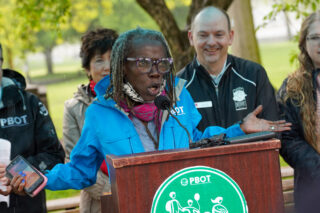
Warner’s boss, PBOT Commissioner Jo Ann Hardesty, said this project is about much more than concrete and curbs:
“As we continue to build and grow our city’s network of safe and friendly places to walk and bike — not just downtown, but in every part of our city — I will think about moments like today, where we all came together, no matter how we move, and enjoy this space as one Portland. Because that’s really what Portland is about. We want to open up our streets, our communities and our hearts to everyone. Because we know we are better when we do. It’s what we need to help us heal from these traumatic last few years… Today’s a celebration of what community can accomplish when we come together.”
Hardesty also reminded the crowd that May is Asian American and Pacific Islander Heritage Month and how Naito Parkway was named after William Naito, a Japanese immigrant who helped revitalize Old Town, downtown and Montgomery Park in the 1970s, 80s, and 90s. “Without the Naito family, it’s hard to imagine what Portland would be like today,” Hardesty said.
After the ribbon was cut Hardesty jumped into a pedicab to try the new lane out for herself. I asked if she felt it would make people safer. “It’s going to be 100 times safer. I just can’t think of a better way to revitalize the city!”
As we rode side-by-side and had a conversation, I recalled how seven years ago this was a dangerous place where drivers would go 35-40 mph and squeeze by us as we clung to the curb. Now it’s calm and there’s plenty of breathing room.
As I looped back I looked up and saw someone in an electric mobility device. It was Cassie Wilson, an activist who’s fought freeway expansions with Youth Vs. ODOT and who was recently hired by The Street Trust. Earlier this morning I asked if she’d taken her scooter on Better Naito. “I’m still a bit intimidated by it,” she said. But with the support of a friend on a bike, Wilson was able to get over those fears and she smiled as she rolled along.
“It’s just exciting to see,” Wilson shared. “It’s exciting to have something to celebrate, instead of fighting against.”



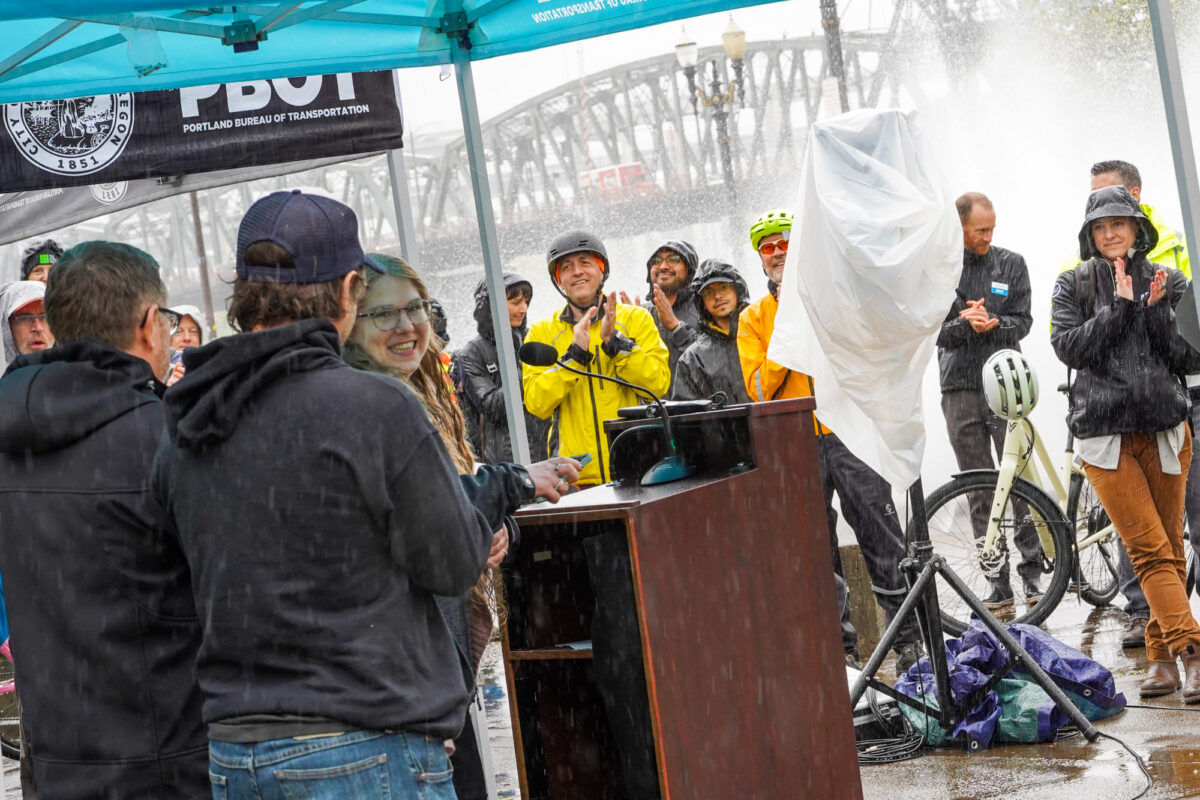


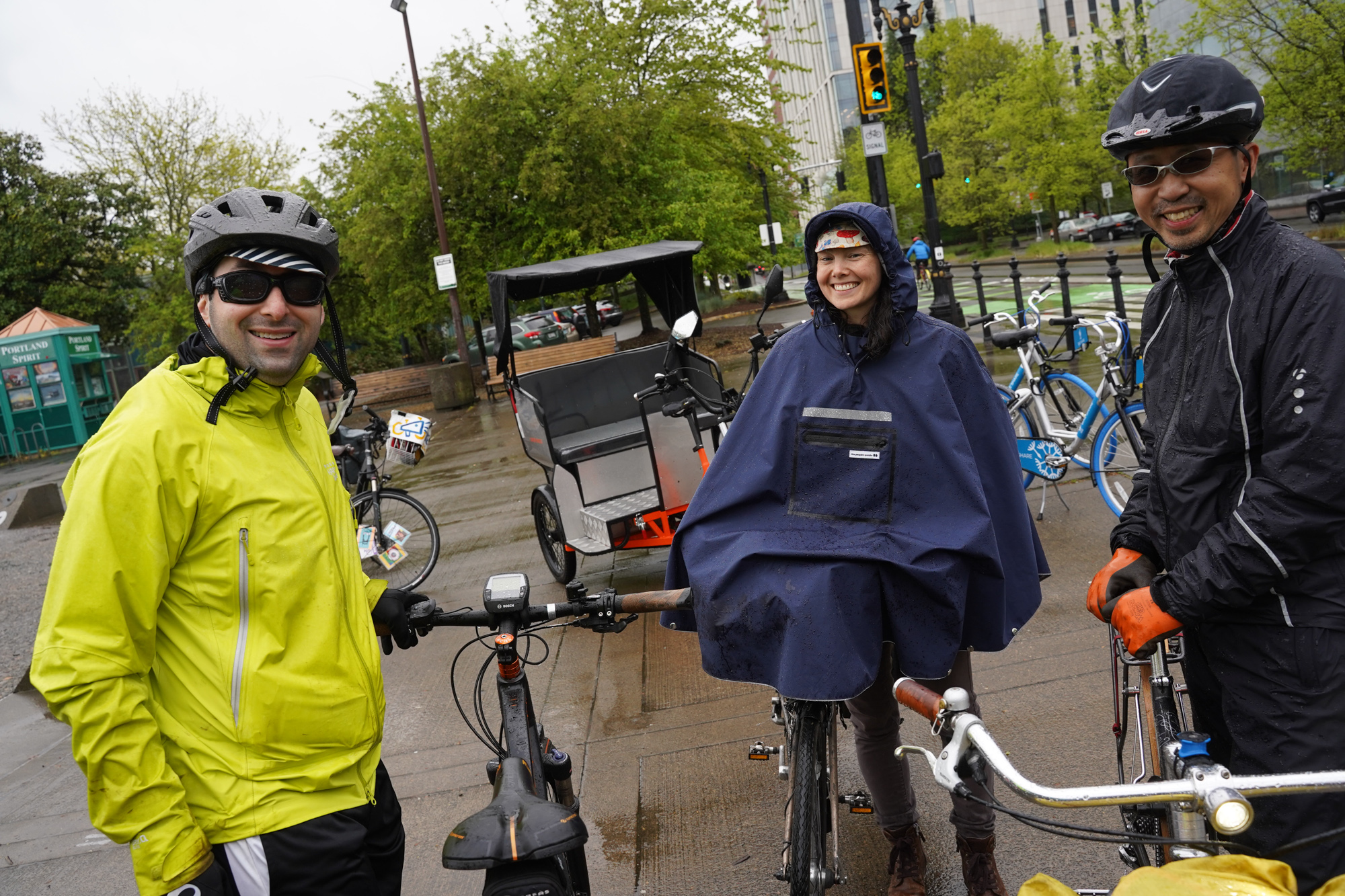
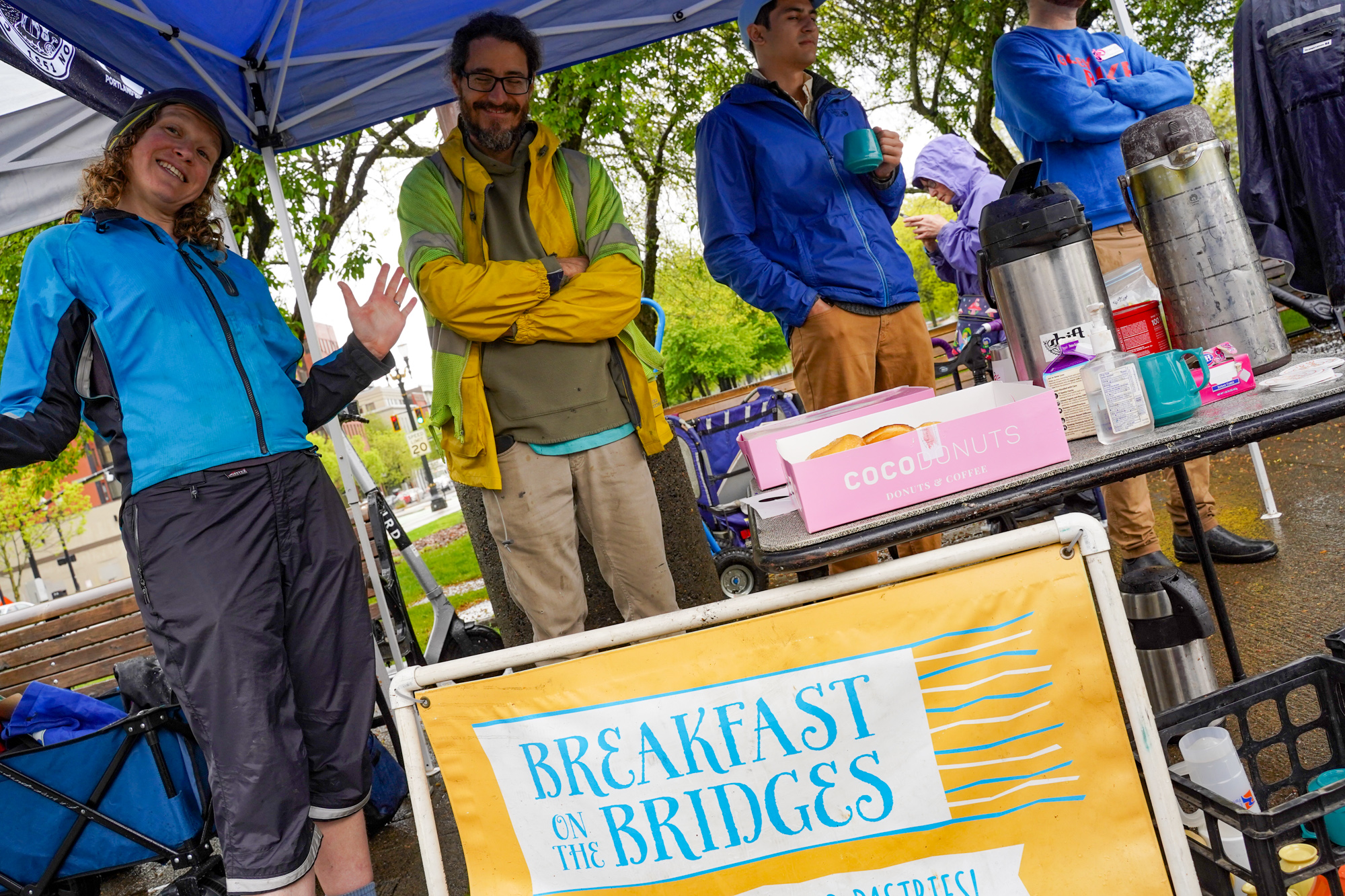
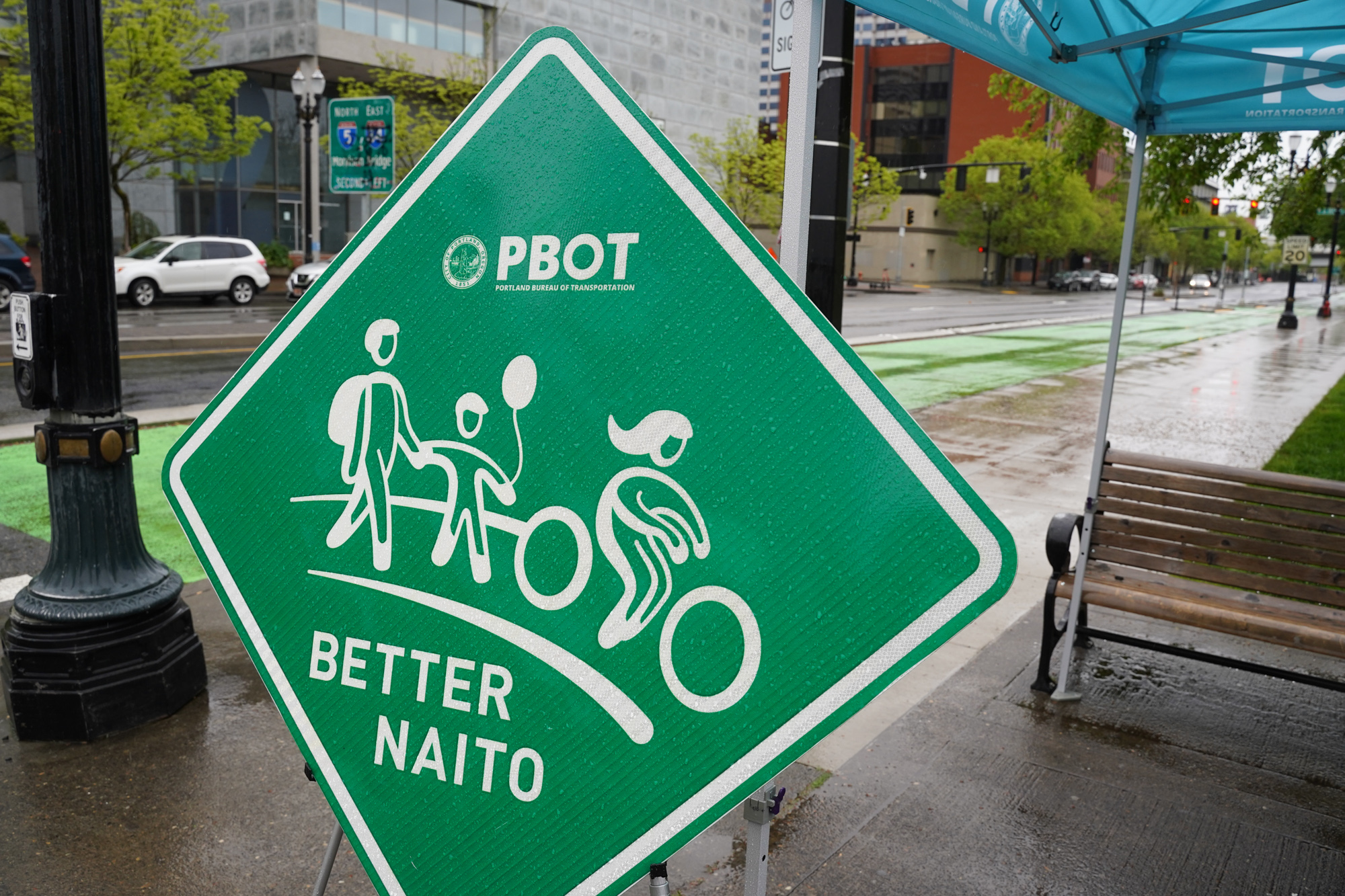



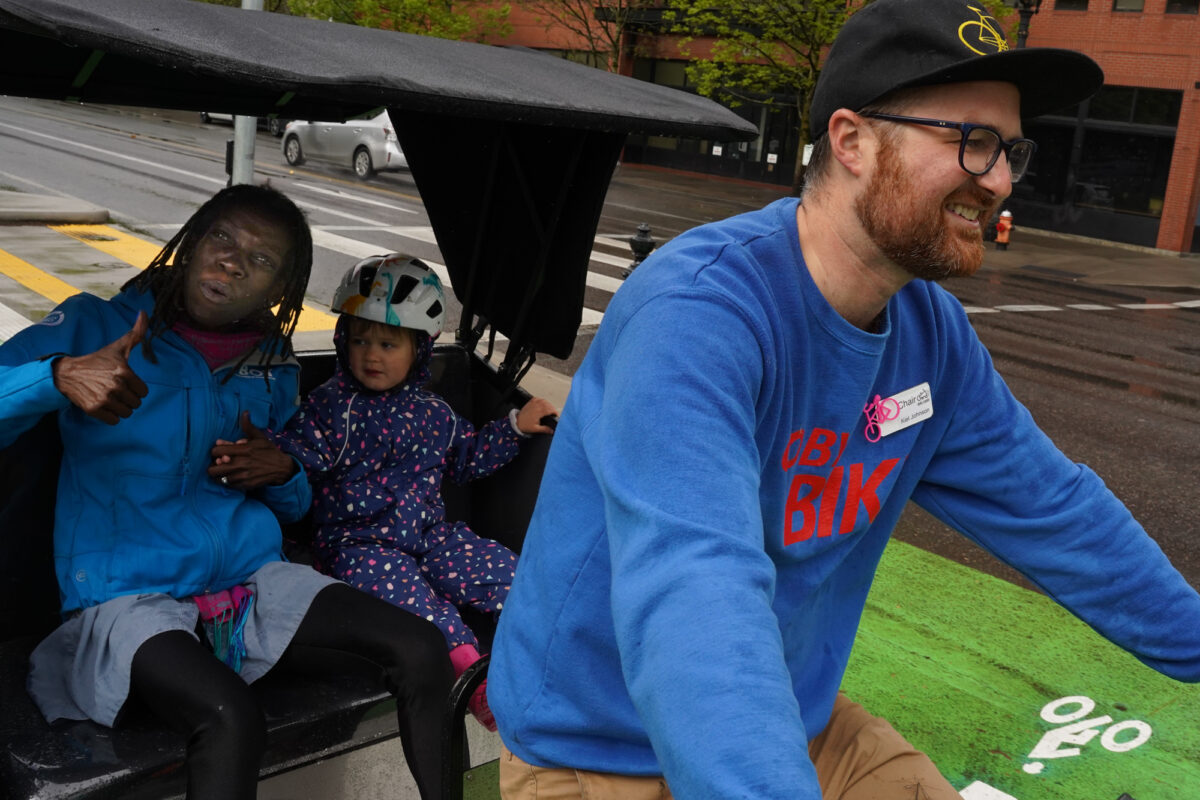
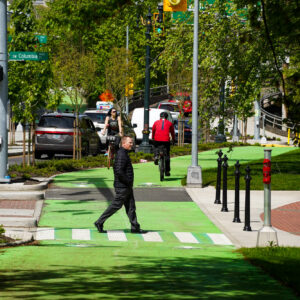
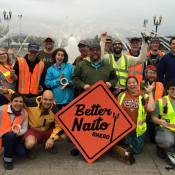
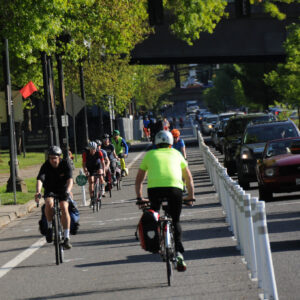

Thanks for reading.
BikePortland has served this community with independent community journalism since 2005. We rely on subscriptions from readers like you to survive. Your financial support is vital in keeping this valuable resource alive and well.
Please subscribe today to strengthen and expand our work.
Better Naito is a success story on a number of fronts: it’s a success story of accessible government, tactical urbanism as a way of urban planning, partnerships, data, and imagination. As someone who helped lead this effort from the City Hall side, here is some context and history for people who weren’t around 7 years ago.
Better Naito was not on any Portland planning document at the time. The festival season had just started in 2015 and the loading permits the festival had required them to open the northbound lane for cars during rush hour. In essence, what Better Naito did was somewhat of a marketing spin, at least at first. We essentially glorified the loading zone into a premier walking and biking space. The fact that there were occasional trucks there didn’t bother us at first because the loading is what gave us the political cover to do this trial in the first place. Moreover, from a permitting perspective, instead of saying the N-bound travel lane had to be open [for cars] during rush hour, we simply changed the permit to allow continual walking/biking/loading during rush hour and overnight. This is what created a 24 hour multi purpose lane for 2 weeks during the 2015 Rose Festival.
It was a delicate dance between Better Block, Festival organizers and the City about who would apply for the permit, what type of permit, who would procure and set up traffic cones, where the $15,000 to do this pilot would come from, what the messaging would be, who would collect data, and how success would be defined.
This was very much a leap of faith and there were a number of things we didn’t know until we did it. First, we didn’t know how popular it would be from a biking perspective in terms of bike counts and network importance. I remember biking around in those early days and having my jaw drop at the number of northbound cyclists and how many people were turning on/off at Salmon, Taylor, Oak, Harvey Milk Streets. We quickly captured these numbers and had the data help tell the story of something like 1 in 3 northbound commuters in the PM peak were travelling by bike. Second, we didn’t know the traffic signals on Naito Pkwy were separate from the downtown grid, thereby making them easier to tweak in support of the Better Naito pilot project. Third, we found out that the demand and importance of southbound and northbound Naito were unequal. Specifically, Southbound Naito carried more vehicle traffic due to accessing I-5 and it was more important for emergency response due to the fire station at NW Ash and Naito. Northbound Naito didn’t have these same pressures.
We also underestimated how important the biking/walking space was for the City. It was important not just from a “big picture” multimodal/policy perspective but also from a “little picture” of achieving Parks bureau, emergency response bureaus, and transportation bureau’s goals related to safety and access for waterfront park. Having this space free from car traffic made city operations run smoother and contributed to a happier and more memorable experience for visitors, tourists, and commuters.
Better Naito was also a success in bridging the connection between grassroots tactical urbanism and the halls of power in city government. If the project didn’t go well, Better Block PDX was willing to take the heat. If it went well, the City was able to claim a victory while being somewhat more insulated from the political risks. The City also contributed its own assets and resources to make the project a success. For example, potholes were filled and PBOT staff enforced no-parking rules in the space. Parking enforcement and filling potholes are things PBOT does in the ordinary course of business but it was significant that those efforts were directed to the Better Naito pilot project. Eventually, of course, the City ended up taking on Better Naito as a summer pilot project which further institutionalized Better Naito and temporary uses of streets. The fact that public perception of Better Naito was positive and only got better is due to Better Block, Festival organizers, and the City working together on messaging, triaging issues, and putting in significant effort toward a successful pilot.
There are a lot of people to thank and I can’t name them all but shoutout to Ryan Hashagen, Gwen Shaw, Yelena Prusakova, and Ben Chaney from Better Block PDX as well as countless advocates who helped set up traffic cones at 5am, Portland Rose Festival, and city staff (too many to name but high fives all around) from Parks, Fire, Police, and Transportation bureaus as well as city hall. Initial seed funding for the project was provided by People for Bikes and Metro. It is still incredible to see that the initial $15,000 pilot project leveraged over 15 million dollars of public investment to create a high quality multimodal space on Naito Parkway between SW Lincoln Street to NW 15th Avenue (3 separate PBOT capital projects on Naito since 2015).
Here is a link to the 2015 video of Better Naito:
https://www.youtube.com/watch?v=YmNK6upDzLY
Next time you are in Portland’s waterfront, take a minute to reflect that people’s minds, political calculations, streets, and cities can be changed in service to more livable, equitable, and memorable places.
Timur, thank you for this context.
This is great! Thank you Timur for your hard work and your detailed history, and thank you Jonathan for your comprehensive reporting. I *was* here 7 years ago but had no idea of the breadth and depth of this work.
It’s so important to celebrate these victories AND have the recorded history of how they were accomplished so that we can build on them in the future!
Timur, thanks for all your hard work and spirit over the years bringing people together for real progress on this and other projects. And thank you to everyone else who worked so hard to make this happen.
” . . . people’s minds, political calculations, streets, and cities can be changed in service to more livable, equitable, and memorable places.”
This hopefulness and can-do attitude, and the collaboration of so many different individuals and entities, ultimately resulting in actual success, is one antidote to cynicism.
Over the last two years, as I rode past and saw PBOT crews working on Better Naito and other forward-looking soft-mode infrastructure, I felt hope well up. More than anything else, this work made me feel, that in spite of our many differences and incredibly challenging problems, this city was only going in one direction, and that is UP.
you rule, Timur, thanks for all you did behind the scenes for Best Naito
Great project.
I am concerned, however, that this ceremony occurred in the middle of an election period where ballots are actually out, with full-throated PBOT participation and publicity- including for its boss commissioner. While this may not be illegal, in my opinion such thinly disguised electioneering by PBOT on behalf of a candidate should not be allowed to happen during window around an elc tion- such as 30 days before an election. At best it is unethical cronyism. It seems to me that the event could have waited until after May 17 and the end of voting.
PBOT did the same thing last year for Eudaly, and I suspect its efforts to promote a candidate this year will have the same success.
IDK, I say let the electeds celebrate the W when they help out with something positive. It’s part of the positive feedback loop that might help foster the political will it takes to stand up against bad actors like the PBA.
What’s new? They do it every time. Campaign ethics is not something I associate with any politicians, not even in Portland.
A grand opening certainly helps elected officials celebrate the win, and it’s also a great way to get some press around something new. Bike folks have been hankering for Better Naito to be done and open for ages. Many folks have been avoiding the area because of the construction. Getting this officially opened and announced and celebrated during May Bike Month, as lots of folks are going back to offices and seasonal bike commuters are dusting off their bikes, makes a ton of sense. I’m glad they didn’t wait. The ceremony was part of how I knew it was done and I could use it.
Yes, a job well done by all the squeaky wheels (Better Block, Policy Makers’ Ride, PSU, etc.). It will be interesting how the future looks back on this project (and its future offshoots – I hope) …will ‘Choo Choo Charlie’ now be better known for this project spark vs the 2000s streetcar? It again shows the power of grassroots imagination…especially with other [politically supported] projects with street lane closures show that the “world does not end” when multi lane mid century designed arterials have a travel lane disappear… from the old Waterfront Highway to Better Naito!
https://www.cnu.org/highways-boulevards/model-cities/portland
[The CNU needs to update its Naito Page! 😉 ]
Now the question is which PDX arterial will be next to out “Better Naito”?
So many amazing, lovely people had a hand in this. I love you, thank you. You showed us what is possible.
Finally, the pandemic has ended – a maskless Portland event…
It’s taken us a while longer up here to understand science.